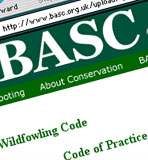| Contact us |
| Try wildfowling |
| Club merchandise |
| Wildfowl art |
| Wildfowling books |
| Join KWCA |
| Search |

Wildfowling Code
Code of Practice For Sporting Agents and Guides Offering Inland Goose
Shooting
1. Goose shooting is a traditional and highly valued recreation for many
people. If carried out responsibly it brings sustainable economic benefits
to rural areas and helps prevent damage to crops.
2. Agents and Guides must make their clients aware of the law concerning
goose shooting, in particular that:
a. It is illegal to use a semi-automatic or repeating shotgun with a magazine capacity of more than two cartridges for shooting geese or other wildfowl
b. It is illegal to use a tape recording to attract geese for shooting
c. It is illegal to sell, exchange or barter wild geese or any part of them (only sufficient birds should be shot to satisfy the requirements of the shooters or their friends)
d. The shooting of ducks and geese in Scotland on a Sunday is prohibited
e. The penalty for a) and b) above is £5,000 (maximum) The penalty for c) is a fine of £500 (maximum) The penalty for d) is £1,000 (maximum)
3. Putting out food to attract geese for shooting is
completely unacceptable and those responsible for shooting parties must
ensure that farmers on whose land they shoot do not do so.
4. There should not be more than eight guns in a shooting party which
must be supervised by at least one experienced guide who has been properly
brief has been properly briefed as to his responsibilities. Safety considerations
must be paramount at all times.
5. Those responsible for shooting parties must instruct clients in range
judgment before taking them out and stop out of range shooting immediately
if it is observed. Extra Guides must be provided to ensure adequate supervision
of inexperienced guns.
6. Shot sizes of 1 or 3 are widely considered the best for goose shooting
at a normal maximum range of 30 meters. However experienced guns may use
shot sizes BB or 4 in suitable circumstances. Every effort should be made
to minimise wounding and to retrieve all shot birds.
7. Those responsible must provide instructions on the identification of
quarry and protected species and provide adequate supervision while shooting
is taking place. It is illegal even to shoot at some goose species.
8. Generally geese feed by day and roost at night on water or on large
open areas. Excessive disturbance can cause geese to desert traditional
roosts and feeding grounds: it is therefore preferable to shoot them on
flight lines between feeding and roosting areas.
9. Shooting geese leaving their roost in the morning causes fewer disturbances
than shooting them when they return in the evening. Shooting should not
take place at inland roosts more than once a fortnight.
10. Geese must not be harried all day. Shooting should generally stop
two hours after sunrise and the ground left undisturbed for the rest of
the day.
A bag
11. A bag limit of five Pinkfeet or three Greylag per gun shooting session
should be observed. Because of possible changes in goose populations bag
limits may be altered from season to season.